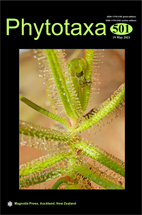Abstract
Phylloporia moricola is described as a new species based on collections from Sichuan Province, China. All studied basidiocarps grow on trunks of Morus sp. This new species is supported by morphological features and phylogenetic analyses of DNA sequences inferred from a dataset of nuc 28S rDNA. P. moricola is characterized by having effused-reflexed to pileate basidiocarps, pores 7–9 per mm, duplex context with a black line when young, dimitic hyphal system, and brownish, slightly thick-walled basidiospores generally measuring 3.4–4 × 2.7–3.2 μm. Phylloporia moricola is phylogenetically most closely related to Phylloporia mori, that also occurs on Morus sp., but that species differs from P. moricola in having hymenial setae and larger basidiospores (4–4.8 × 3.1–3.8 μm).

